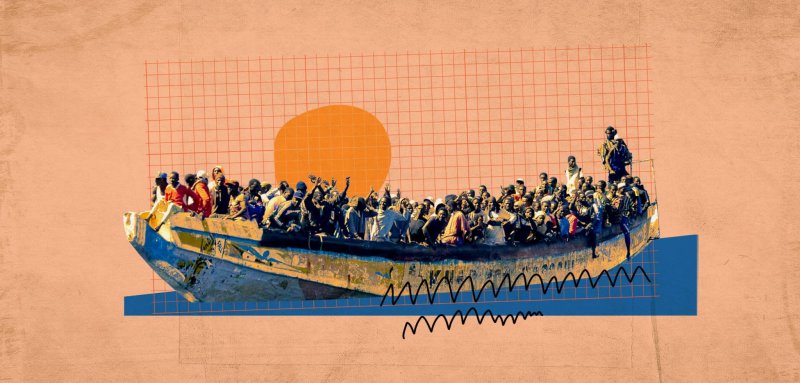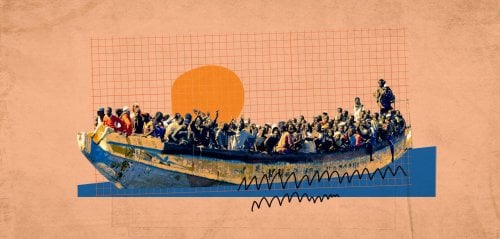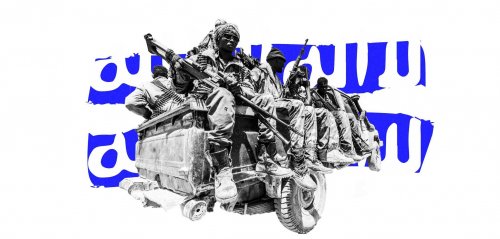The journey from the Horn of Africa to the Gulf states via Yemen—known as the Eastern Migration Route—accounts for 40% of global migration movements. In recent years, the number of migrants taking this route has steadily increased. With the escalation of armed conflict in Yemen since March 2015, large flows of African migrants have sought refuge and better opportunities in Gulf countries, often facing perilous and harsh conditions along the way.
Smuggling and human trafficking networks commit horrific violations and grave abuses against irregular African migrants. Testimonies reveal that these cross-border crimes are often carried out with the complicity of security officials affiliated with factions in the Yemeni conflict, who accept bribes to enable these operations without legal repercussions.
Despite the large number of migrants arriving in Yemen, the international community’s response to their plight has been inadequate. 6,364 migrants entered Yemen in October 2024—the highest monthly influx since July 20230–according to the International Organization for Migration (IOM), .
The majority of these migrants (89%) are from Ethiopia, while 11% are from Somalia. Many cite economic reasons for their migration, driven by desperate attempts to escape war in their home countries and the lack of job opportunities for those without university degrees. Meanwhile, the weakness of Yemen’s central government, the lack of control over its coasts, and the porous borders with Saudi Arabia and Oman further encourage this migration route.
Key gathering points
African migrants typically travel through coastal countries, departing from areas in Djibouti and Somalia to reach Yemen by boat via the Red Sea and the Gulf of Aden. Departures often occur from the shores of Hayyou, Obock, and Khor Angar in Djibouti, as well as from Bosaso in Somalia.
Human trafficking gangs falsely paint this journey as a pathway to "wealth," luring desperate migrants into a dangerous trek toward the Gulf through Yemen.
Smuggling and human trafficking networks commit horrific violations and grave abuses against irregular African migrants. Testimonies reveal that these cross-border crimes are often carried out with the complicity of security officials affiliated with factions in the Yemeni conflict, who accept bribes to enable these operations without legal repercussions.
The human trafficking gangs operate along the entire route. Migrants are often crammed into small, overcrowded fishing boats, with as many as 150 to 200 people per trip, tossed around by waves and battered by strong winds. Smugglers and traffickers risk their lives and those of their passengers during the treacherous sea voyage, which is prolonged by adverse weather conditions, particularly during the windy seasons. To evade coast guard patrols, these boats—typically manned by armed smuggler gangs—face extreme dangers, including rough waters and severe weather. Upon arrival in Yemen, smugglers coordinate with local networks to facilitate the migrants' further passage inland.
Many coastal entry points in Yemen serve as gateways for migrants along the coast. Among the most prominent are Ra’s Al-Arah and Al-Madaribah in Lahj Governorate, Rudum in Shabwah, and Mokha along the southern Red Sea. The migrants then gather in major cities such as Aden, Ataq, Rada’a, Al-Bayda, Sanaa, Mukalla, and Marib, before eventually reaching Souq Al-Raqou and Souq Al-Thabet in Saada—two key gathering points before crossing into Saudi Arabia.
Smuggling gangs
Local smuggling gangs often collaborate with networks in Djibouti and Somalia to traffic thousands of African migrants into Yemen, which serves as a major transit hub to Gulf states, generating millions of dollars in illicit profits.
The financial burden of migration is great on those seeking it. Fees range from $60 to $200 per person for sea crossings and can reach $550 for the final stage into Saudi Arabia. Despite the high costs and associated risks, demand for migration continues to rise, fueled by conflicts in countries such as Ethiopia and Somalia.
In Yemen alone, smuggling gangs are estimated to generate millions in annual revenue—far exceeding the profits made from smuggling operations on the African coasts of Djibouti and Somalia.
The fees required to smuggle an individual range from $60 to $200 for sea crossings and can reach up to $550 for the final stage into Saudi Arabia.
Smuggling and human trafficking gangs operate holding yards and enclosures where migrants are gathered before transport arrangements are made, extracting payments for their services. Using systematic procedures, these gangs build trust with migrants and establish partnerships that ensure the success of their smuggling operations.
In an audio recording obtained by Raseef22, a witness, Mohamed Hassan Walo, stated that his relative, Hassan Omar Jama, was extorted by individuals in Dhamar Governorate. These individuals, whose official titles he did not know, demanded 5,500 Saudi riyals ($1,465) for his release and permission to continue his journey toward the Yemeni-Saudi border.
Walo points out that it is common for smuggling gangs to collect money from victims in a designated area in Dhamar, which serves as a gathering point for African migrants and refugees before facilitating their passage.
The entry and gathering points for migrants across various Yemeni provinces create environments where these violations and abuses thrive. Smuggling networks profit from their illegal activities, showing blatant disregard for the lives of migrants by committing horrific crimes, including murder, sexual violence, torture for ransom, forced labor, and financial extortion. Raseef22 has reviewed video footage showing African migrants being brutally tortured to extract ransom payments from their families.
Unfortunately, these smuggling and trafficking gangs operate with no legal consequence. Current security efforts to dismantle them remain insufficient amid an urgent need for coordinated security measures to combat these networks and hold those responsible for crimes against migrants accountable. There are often collaborators within local authorities, including the coast guard and security forces, while various factions in the Yemeni conflict cooperate with smuggling operations.
These gangs pay bribes at checkpoints and to security officials linked to the Southern Transitional Council, the Houthis, and the internationally recognized government, enabling the trafficking and smuggling of African migrants. Ironically, while strict restrictions are imposed on the movement of Yemeni citizens, these human trafficking networks enjoy freedom of movement within the country.
Smuggling and human trafficking gangs operate with impunity, significantly impacting national and regional security in migration-affected areas. These gangs engage in illegal activities, often exploiting the desperate needs of unregistered migrants for work. Migrants are frequently used to transport contraband across borders, particularly along the Yemeni-Saudi perimeter line, where some resort to smuggling qat and other banned substances into Saudi Arabia. In addition to such exploitative practices, these gangs commit severe crimes against migrants, endangering their lives and subjecting them to violence.
The harsh realities of migration
Migrants face grueling journeys, often traveling over 1,000 kilometers on foot or in overcrowded vehicles under harsh conditions. African migrants typically take perilous and complex routes, relying on smuggling and trafficking networks that use unsafe and inadequate transportation. These journeys expose migrants to direct abuses, including various forms of violence, as well as indirect risks such as airstrikes, landmines, and explosive devices.
The migrant gathering points in Yemen’s provinces create environments where abuse multiplies, as smuggling networks blatantly disregard migrant lives by committing heinous acts, including murder, sexual violence, torture for ransom, forced labor, and financial extortion.
In another distressing video obtained by Raseef22, Amina, an Ethiopian migrant, is seen in a rugged mountainous area along the Yemeni-Saudi border, struggling to descend a dangerous slope, crying, and mourning the loss of her friends who were killed by a human trafficking gang after failing to pay ransom in Saudi riyals for their release.
The Eastern Migration Route poses immense challenges for African migrants seeking a better life. The horrific conditions they endure, coupled with the complicity of local authorities and the thriving operations of smuggling networks, highlight the urgent need for a coordinated international response. Addressing the root causes of migration, strengthening border security, and holding traffickers accountable are crucial steps to protecting vulnerable migrants and restoring their dignity in the pursuit of a safer future. Without immediate action, the cycle of exploitation and suffering will persist, therefore deepening the region’s humanitarian crisis.
Raseef22 is a not for profit entity. Our focus is on quality journalism. Every contribution to the NasRaseef membership goes directly towards journalism production. We stand independent, not accepting corporate sponsorships, sponsored content or political funding.
Support our mission to keep Raseef22 available to all readers by clicking here!
Interested in writing with us? Check our pitch process here!









